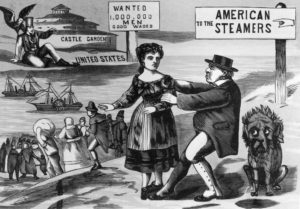By Elizabeth C. Goldsmith (Regular Contributor)
 America is a country of immigrants. Literature and films like the recent Brooklyn depict the familiar story of immigrants arriving by ship, overcoming great difficulties, and eventually learning to embrace a new life full of promise. But the immigrant experience has also always included huge numbers of people who turn around and go home.
America is a country of immigrants. Literature and films like the recent Brooklyn depict the familiar story of immigrants arriving by ship, overcoming great difficulties, and eventually learning to embrace a new life full of promise. But the immigrant experience has also always included huge numbers of people who turn around and go home.
In the first decades of the twentieth century, more than half of the nearly two million Italian immigrants who arrived in New York returned to their homeland. The same was true for Greeks, Russians, and Eastern Europeans. The percentages of returned immigrants from England and Ireland were lower, but still amounted to over two hundred thousand returnees in the 15-year period for which records were kept after 1908.
 Earlier waves of immigrants resulted in mass returns as well. Returning from his tour of America in 1842, Charles Dickens was surprised to discover nearly a hundred returning immigrants among his fellow-passengers. Curious to know their stories, he investigated “with what expectations they had gone to America, and on what errands they were going home, and what their circumstances were.” He learned of their disappointments, homesickness, illness, and poverty that had only been worsened by their travels, observing one starving wretch who was living on the “bones and scraps of fat he took from the plates used in the after-cabin dinner, when they were put out to be washed.”
Earlier waves of immigrants resulted in mass returns as well. Returning from his tour of America in 1842, Charles Dickens was surprised to discover nearly a hundred returning immigrants among his fellow-passengers. Curious to know their stories, he investigated “with what expectations they had gone to America, and on what errands they were going home, and what their circumstances were.” He learned of their disappointments, homesickness, illness, and poverty that had only been worsened by their travels, observing one starving wretch who was living on the “bones and scraps of fat he took from the plates used in the after-cabin dinner, when they were put out to be washed.”
There is a vast ‘remigrant’ literature that has been largely unstudied. Much of it has been lost among the letters and family diaries stored in attics or boxed in dusty parish archives. Some disillusioned immigrants did publish their stories. William Clark, who arrived in New York in 1817 full of hope and curiosity about the new experiment in democracy that was America, was soon disappointed by the harsh conditions he encountered compared to the life he had left in England. He wrote a book intended to warn his countrymen, titled The Mania of Emigrating to the United States. David Mitchell came to America in 1848, as a young clerk seeking wealth and adventure. In his book recounting the experiences that led him to decide to return home, he warns against the temptations of the American myth. His description of the moment when he decided to leave England evokes the dream that the American landscape seemed to offer. In his case, it was a bestselling novel that drew him:
 “I was one day sitting at my small desk, in a little dark cage of a room, with no other business than to look out on the crowded thoroughfare. I had just finished The Last of the Mohicans. The mildness, the freshness, the freedom of the New World, its abundance of land and scope for enterprise and adventure, all delighted and tempted me.”
“I was one day sitting at my small desk, in a little dark cage of a room, with no other business than to look out on the crowded thoroughfare. I had just finished The Last of the Mohicans. The mildness, the freshness, the freedom of the New World, its abundance of land and scope for enterprise and adventure, all delighted and tempted me.”
For this immigrant like so many others, though, the experience of travel was ultimately an exercise in disenchantment, leading to a new appreciation of home. For those who left as for those who stayed, disillusionment and the maturity that accompanied it was an important part of the immigrant adventure. Most of us have still only heard half of their story.
For further reading:
Mark Wyman, Round-Trip to America: The Immigrants Return to Europe, 1880-1930 (Ithaca, N.Y., 1993).
Wilbur Shepperson, Emigration and Disenchantment (Norman, OK, 1965).
D. W. Mitchell, Ten Years in the United States (London, 1862).
William Clark, The Mania of Emigrating to the United States (London, 1820).
